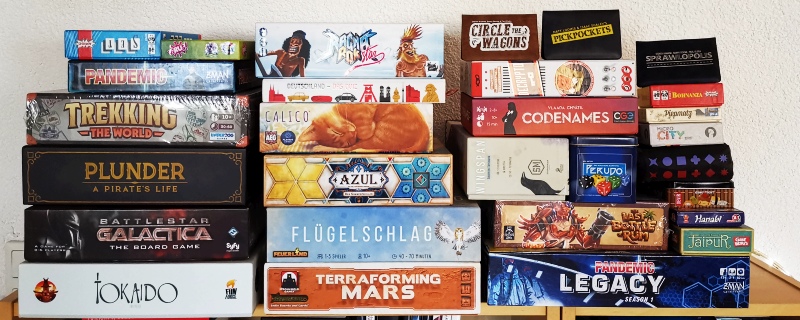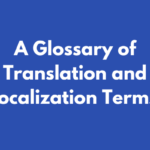I don’t know what your upbringing was like, but when I grew up, my parents had Monopoly, Mensch ärgere dich nicht, Scrabble and Halma, and that was the extent of my board game education. While Scrabble and Halma can be quite fun to play, I don’t have a lot of love for the other two, and so I was never particularly interested in board games growing up. Instead I spent my time playing video games – which is also why I became a video game translator as an adult.
It wasn’t until many years later that someone made me play Pandemic, probably the first coop board game I’ve ever played, and I loved it. That’s when I realized how many great games were out there – and I was hooked. I’m currently deep into a game of Pandemic Legacy and have discovered many other non-coop greats like Wingspan, Codenames, Jaipur, Tokaido or Terraforming Mars just to name a few. Let’s just say the hobby is wreaking havoc on my shelf-space.

It feels like a natural progression then that I’ve started taking on translations of board games as well. But enough about my backstory – let’s see what you as a developer should consider to ensure you get a good translation for your board game.
1. Good things take time
It’s easy to underestimate the effort that goes into a good board game translation. If you’re not a translator, you might think it’s perfectly reasonable to send off 10,000 words one day and expect to have the translated file waiting in your inbox the next morning. Unfortunately, that’s not how it works.
Depending on the complexity of the source text as well as each individual translator’s typing (and thinking!) speed, it’s more realistic to calculate with 2500 words per day. Some translators do less, some can do a lot more, especially if they’re using a CAT tool and the text is slightly repetitive, but 2500 words/day is commonly seen as a good average value. So in theory, your 10,000 words should take about 4 working days to translate.
Next, if you want the text proofread by a second person, add another 2 days for that. It’s fairly standard in the translation industry to have a second person perform a proofreading step – not because your translator might do a shoddy job, but because our human brains are so evolved that they like to read what they know SHOULD be on the page rather than what’s actually on it. My professor at university called this home blindness. That’s why a “fresh pair of eyes” is very helpful for spotting typos and other mistakes.
Lastly, freelance translators tend to juggle a lot of projects at once, especially if you didn’t or couldn’t tell them a long time in advance when to expect your project. If they’re working on something else in parallel, those six days might stretch to two working weeks.
Summary: Give your translator ample time to work on your project and be sure to factor in translation when you’re working out deadlines for sending files to the printing press and whatnot.
2. Provide context and reference materials
You may not know the old translator joke:
Q: How many translators does it take to screw in a lightbulb?
A: Depends on the context.
It’s true, though, that the context of a sentence or word will completely change its meaning. You know: Time flies like an arrow, fruit flies like a banana. As a consequence, it’s best to provide ample context to your translator, so they always know what the text refers to and how the mechanics work (and they don’t need to bother you with countless questions). When I translated DinoGenics, I was lucky enough that I could play the game on Tabletopia to get acquainted with it. (It’s a great game, by the way. Go try it out for free.)
Obviously in an ideal world, you could provide your translator with a copy of your game in its source language. Second best would be a print-and-play copy of your game or a digital version. If all this isn’t possible, even a video of you playing the game would be useful to make sure the rules are clear. If none of this is possible, make sure you’re available for any questions that come up during the translation process.
Similarly, if there have been previous versions of your game that were translated, or your project is an expansion or variant of an existing game, be sure to provide your translator with any previously translated files. If your game is getting a Legacy version and suddenly your money tokens or your game components have different names, your customers might get annoyed.
Summary: Provide your translator with a way to play your game, a video of someone playing the game, or at least be available for any questions that come up during the translation phase. Be sure to send them any available reference material.
3. Finalize your text or plan for revisions
The best thing for a translator in video game translation as well as board game translation is if we get the final product in the source language and we have all the time we need to translate it into our respective target languages. I have the feeling that in both areas of translation, this rarely ever happens. Developers often change text up until the last minute (or after the last minute with a patch), and even in board games developers might find things they want to quickly rewrite or add for clarity before it all goes to print.
Revisions aren’t problematic as long as you plan for them. Let your translator know if you’re still changing things, so they can schedule this task in advance (and put it in the budget). Don’t send 25th-hour requests that require a response within the hour. If you do change parts of your text, make sure you mark them adequately so your translator can find the corresponding passages and make the necessary revisions.
Summary: Make sure your translations are as final as possible when you send them to the translator and be sure to let them know in advance if you’re expecting to make revisions while the work is on-going.
4. Don’t forget DTP
If you’ve created a beautiful manual in desktop publishing (DTP) software like Adobe InDesign, you should make sure in advance that the translator you hire can work with InDesign files. Also, make sure you agree on the scope of their work. If your translator thinks you only expect all the English text to be turned into German text and you’ll do all the layouting yourself afterwards, this might lead to a rude awakening for both parties. German translations usually turn out to be a lot longer than the English text, and fixing the layout – if your translator is even able to do this – can take a considerable amount of time.
I personally own an Adobe InDesign license and do offer DTP services – heck, I’ll admit, I even enjoy doing it! However, experience has shown that it can take quite a while to fit all those horribly long German words and sentences into space that was designed for an English version. Sometimes the only solution is decreasing the font size by 1 – and even then you might still have to move some headlines or images around. For this to be as painless as possible, it’s important that you deliver a source file that is well formatted. (By which I mean: Don’t force line breaks by hitting the spacebar 50 times or other such shenanigans.)
Summary: If you don’t think you can fix the layout of the final manual/box/playing cards in a foreign language, make sure to request DTP services beforehand and provide the source text in a file that has good formatting.
5. Pay your translators
I’m a translator, so I’m clearly biased on this point, but translation is a skill and for many of us it’s how we make a living. I wouldn’t expect a plumber to fix my toilet for free – and if someone did install a new toilet for free, I’d have to be willing to accept that even if they did the job to the best of their ability, they might not be able to provide the best quality. I’d say it’s better to pay a plumber with plenty of plumbing experience!
Having said that, it’s also a sad truth that next to a few extremely successful board games, there are also many more that won’t be selling so well, even if they are good, and board games can cost a lot of money to produce. I have a lot of respect for anyone who manages to bring their project to completion – it certainly seems like an insurmountable task from the outside! So if your board game has a very small budget, and an even smaller budget for translation – talk to your translator and see if you can work something out. Maybe they’ll have a solution for you, maybe they’ll say no, but it’s all good as long as everyone’s polite, right?
Summary: Be aware that good translators can’t work for free.
I hope this was helpful for you and gave you some insight into board game translation from a translator’s perspective. If you have any questions, be sure to let me know, and don’t be shy to contact me about a free quote for your next board game translation project!
If you like, you can also sign up for my newsletter to be informed of any new articles I publish.





